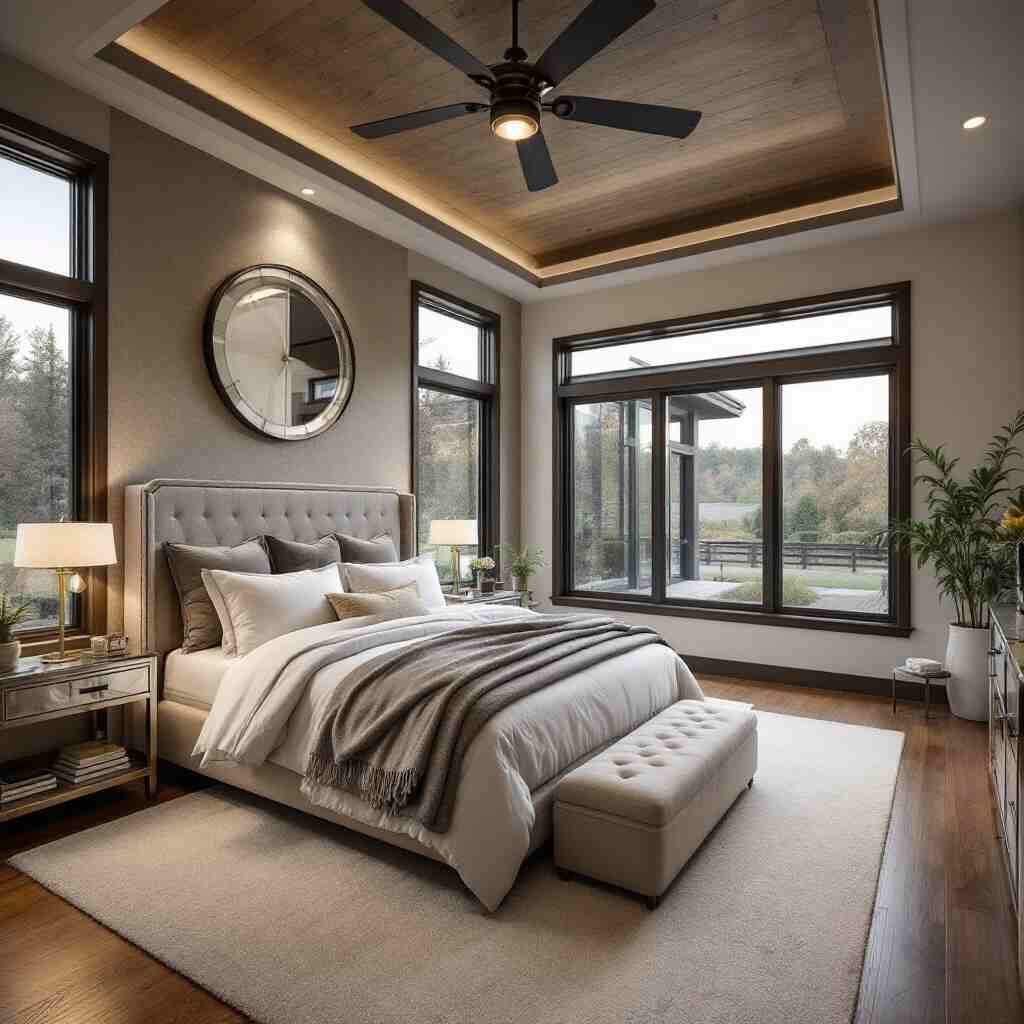homeThe master bedroom is, more than just a place to sleep, a retreat from the busy-ness of life. Master bedroom dimensions matter, as they impact how comfortable this space is, and what you can fit inside.
| Square Feet | Ideal Bed Size | Features | |||
| Master Bedroom | 14′ x 16′ to 16′ x 20′ | 224–320 | 200–300 | King or California King | Walk-in closet, en-suite bathroom, sitting area, large windows, optional balcony access |
| Size | Dimension (feet) |
|---|---|
| Small | 12’ x 14’ |
| Medium | 14’ x 20’ |
| Large | 16’ x 24’ |
| Home Type | Average Master Bedroom Size (sq ft) | Average Master Bedroom Size (ft x ft) |
|---|---|---|
| Standard | 200 – 350 | 14×14 to 18×20 with 14×16 being the average |
| Small Homes | ~200 | 14×14 |
| Large Homes | >350 | 20×20 or larger |
| Luxury Homes | 400 – 600+ | 20×20 to 25×25 or larger |
What is a Master Bedroom?

A master bedroom is usually the largest, most luxurious bedroom in a home. It usually comes with luxurious touches such as an en-suite bathroom, walk-in closets and a seating area, creating a comfortable, private sanctuary in the house.
- What Factors Affect the Size of a Master Bedroom?
- Below are a few things that can affect a master bedroom size:
- Home Size: The general dimensions of a home can also have a substantial impact. Generally speaking, larger homes have larger master bedrooms.
- Building Codes: These laws can set the floor for the size of rooms, bedrooms included.
- Lifestyle and Furniture: Depending on how big and many pieces of furniture you want to fit in the room, that will influence the space you need. For instance, do you need to fit a king-size bed versus a queen?
You may also read (unique bedroom art custom neon signs for your space)
Typical Master Bedroom Dimensions in the U.S.

Master bedroom dimensions vary but are generally between 14 x 14 feet and 18 x 20 feet. Average Size: About 200 to 350 square feet Here’s what these sizes look like, according to home type:
- Small Homes: Average size of 200 sf (e.g. 14 x 14 sf.)
- Standard Homes: 200 to 350 square feet (14×14 to 18×20 feet)
- Big Homes: On average, larger than 350 sq ft (20×20 ft or larger).
- Luxury Homes: These are generally 400 to 600+ sqft (20×20 to 25×25 ft)
Dimensions & Furniture in the Master Bedroom

The layout is key in a master bedroom. A king-size bed, for instance, is approximately 76 inches wide by 80 inches long, and you will need room to move around it comfortably and add any other pieces of furniture, as well. Expected dimensions of common furniture:parametric anharmonic states
- Nightstands: Approximately 1’6″ x 1’6″
- DRESSERS — — ABOUT 3 FT 6 in x 1 FT 10 in
- Walk-in closets Ideally, about 150 square feet
- All of these measurements should be taken into account when configuring your master bedroom layout.
- Master Bedroom Size by Home Type
- Master bedroom sizes vary widely by housing type:
- Apartments could have smaller master bedrooms than houses.
Older vs. New Constructions: New homes often have larger master bedrooms.

- Custom Homes: For example, New Era Homes has a range of master bedroom sizes:
- Independence: 12′ by 15′ (180 square feet)
- Adams: 14′ 1” by 17′ 7” (248 square feet)
- Liberty: 15′ 6″ by 12′ 9″ (198 square feet)
- Commonwealth 1: 15′ 6″ by 13′ 7″ (210 square feet)
- Madison: 16′ 10″ by 12′ 6″ (210 square feet)
Designing Your Master Bedroom: Size Considerations
The size master bedroom you choose really depends on your unique needs and styles. Indeed, even ventilation, natural light and privacy can affect a room’s climate. Master Bedroom Ideas For Small Space
- Top Blunders to Avoid When Deciding How Big To Make A Master Bedroom
- To ensure stands out in planning your master bedroom, you’ll need to avoid certain mistakes which may include:
- Overcrowding furniture: It’s necessary to provide ample space for every piece of furniture you have in your home.
- Neglecting building codes: It’s vital to adhere to local regulations for safety and legality.
- Not planning ahead: Consider how your needs may evolve over the years.
Conclusion
Understand standard master bedroom sizes and how it matters in this comprehensive guide This gives you a better foundation to enhance and optimize your master bedroom to better meet your needs and preferences. Decide what you need, consider the Trade-Offs of each decision, and build the master bedroom of your dreams!
You may also read (7 reasons why your cat waits outside your bedroom door)

